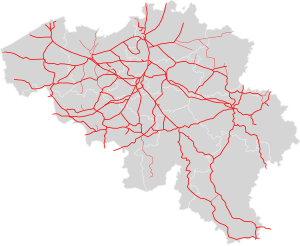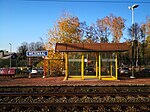 | |
| NMBS/SNCB | |
Native name | Dutch: Nationale Maatschappij der Belgische Spoorwegen French: Société nationale des chemins de fer belges German: Nationale Gesellschaft der Belgischen Eisenbahnen |
| Company type | Statutory corporation |
| Industry | Rail transportation |
| Founded | 1926 |
| Founder | Government of Belgium |
| Headquarters | Avenue de la Porte de Hal/Hallepoortlaan 40, 1060 Brussels , |
| Revenue | |
Number of employees | 16 864 (2023)[1] |
| Subsidiaries | BeNe Rail Eurogare Train World (BE) SNCB YPTO |
| Website | belgiantrain |
The National Railway Company of Belgium (Dutch: Nationale Maatschappij der Belgische Spoorwegen, NMBS;[a] French: Société nationale des chemins de fer belges, SNCB;[b] German: Nationale Gesellschaft der Belgischen Eisenbahnen[c]) is the national railway company of Belgium. The company formally styles itself using the Dutch and French abbreviations NMBS/SNCB. The corporate logo designed in 1936 by Henry van de Velde consists of the linguistically neutral letter B in a horizontal oval.
History
[edit]NMBS/SNCB is an autonomous government company, formed in 1926 as successor to the Belgian State Railways. From 1942 to 1944, amid Nazi Germany's occupation of Belgium, the company was paid 51 million Belgian francs by the Nazi Germany to send 28 trains carrying 25,843 Jews and Roma people to Auschwitz where only 1,195 survived.[2] The company also sent 16,000 political prisoners to concentration camps.[2]
In 2005, the company was split up into three parts: Infrabel, which manages the railway infrastructure, network operations, and network access, the public railway operator NMBS/SNCB itself to manage the freight (B-Cargo) and passenger services, and NMBS/SNCB-Holding, which owns both public companies and supervises the collaboration between them. Essentially, this was a move to facilitate future liberalisation of railway freight and passenger services in agreement with European regulations. Several freight operators have since received access permissions for the Belgian network.[citation needed] In February 2011, NMBS/SNCB Logistics began operating as a separate business.[3]
Faced with rising losses, in June 2012, the Belgian transport minister announced further reform: NMBS/SNCB Holding would be split up, so NMBS/SNCB (the train operator) would be separate from Infrabel (the infrastructure owner). Unions oppose the reform.[4]
NMBS/SNCB-Holding was merged into NMBS/SNCB in 2014 in order to simplify the structure of the Belgian railways.[5]
NMBS/SNCB holds a Royal Warrant from the Court of Belgium.[citation needed]
Operations
[edit]
In 2008 NMBS/SNCB carried 207 million passengers[6] a total of 8,676 million passenger-kilometres over a network of 3,536 kilometres (2,197 mi) (of which 2,950 km (1,833 mi) are electrified, mainly at 3,000 V DC and 351 km (218 mi) at 25 kV 50 Hz AC). In 2024, that number rose to 245 million passengers carried.[7] The rail network has expanded to 3,733 km (2,320 mi) of which 3,286 km (2,042 mi) are electrified.[8]
The network currently includes four high speed lines suitable for 300 km/h (190 mph) traffic: HSL 1 runs from just south of Brussels to the French border, where it continues to a triangular junction with LGV Nord for Paris Nord and Lille Flandres (and London beyond that), HSL 2 runs from Leuven to Ans and onward to Liège-Guillemins, HSL 3 runs from Liège to the German border near Aachen and HSL 4 connects with HSL-Zuid in the Netherlands to allow services to run from Antwerpen-Centraal to Rotterdam Centraal.[citation needed]
National enforcement body
[edit]Sometimes passengers are not satisfied with the answer of railway companies or passengers do not receive any answer in one month,[9] in which case they can seek the assistance of the Federal Public Service Mobility and Transport.[10]
Gallery
[edit]-
NMBS/SNCB MS08/AM08 Desiro train in Antwerp-Central station
-
NMBS/SNCB M7 double-decker train
-
NMBS/SNCB M6 double-decker train
-
Brussels-Central station's main hall
-
NMBS/SNCB MS08/AM08 Desiro train in Leuven station
-
Wezemaal station in 2020 before renovation, with old station sign
-
Kiewit station pylon with B logo
-
NMBS/SNCB MS08/AM08 Desiro train in Kiewit
-
Begijnendijk station in 2020
-
Bouwel station with B logo with level crossing signs
-
B logo in Brussels-North station
See also
[edit]- Eurostar Group - NMBS/SNCB holds a 18.5% stake
- History of rail transport in Belgium
- List of railway lines in Belgium
- List of SNCB/NMBS classes
- Rail transport in Belgium
- Transportation in Belgium
Footnotes
[edit]- ^ Dutch pronunciation: [nɑ(t)ɕoːˈnaːlə ˌmaːtsxɑˈpɛi dɛr ˈbɛlɣisə ˈspoːrˌʋeːɣə(n)] ⓘ and [ɛnɛmbeːˈʔɛs] ⓘ.
- ^ French pronunciation: [sɔsjete nasjɔnal de ʃəmɛ̃ də fɛʁ bɛlʒ] and [ɛsɛnsebe].
- ^ German pronunciation: [ˌnatsi̯oˈnaːlə ɡəˈzɛlʃaft deːɐ̯ ˈbɛlɡɪʃn̩ ˈaɪ̯zn̩ˌbaːnən].
References
[edit]- ^ a b c "Jaarverslag 2023" (in Dutch). NMBS. 31 May 2024. Retrieved 27 August 2024.
- ^ a b Siegal, Nina (15 December 2023). "Belgian Railway Earned Millions for Holocaust Trains, Report Finds". The New York Times. ISSN 0362-4331.
- ^ "Railway Gazette: SNCB Logistics gains independence". Retrieved 13 February 2011.
- ^ "Reforms proposed to cut SNCB losses – Railway Gazette". Railway Gazette International. Retrieved 26 June 2012.
- ^ "History of the Belgian railways". Infrabel. Retrieved 12 May 2018.
- ^ (in French) Jobs B-Rail. Jobs.b-rail.be.
- ^ https://press.nmbs.be/245-miljoen-reizigers-kozen-in-2024-voor-de-trein
- ^ "Geëlektrificeerd deel van het netwerk" (in Dutch). Infrabel. Retrieved 27 August 2024.
- ^ "L_2007315EN.01001401.xml". eur-lex.europa.eu. Retrieved 2 May 2023.
- ^ "National Enforcement Bodies in Europe for rail passengers" (PDF). European Commission. 28 July 2023.
External links
[edit]- Bueker.net – Map of the Belgian, Dutch and Luxembourg rail networks
- SNCB website
- List of stations: Liste des gares SNCB (in French) - Lijst van NMBS-stations (in Dutch)
- Collection of Google Earth locations of SNCB stations (requires Google Earth software) from the Google Earth Community forum.
- Documents and clippings about National Railway Company of Belgium in the 20th Century Press Archives of the ZBW












